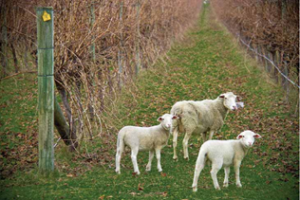Background
Several different tools are used by wine-grape growers across Australia to manage undervine weeds without chemicals. Most growers use a combination of different tools to achieve good weed control.
Sheep grazing is commonly used on conventional and organic vineyards as part of a weed management strategy.

Winter sheep grazing
Action
Generally, sheep are allowed to graze the vineyard floor over winter. When stocked at correct rates, they can keep weed growth down until they are removed in spring. On some high trellised vineyards, grazing is possible all year round, with minimal vine damage.
Advantages and disadvantages
Advantages: Well managed winter sheep grazing can provide very effective weed control across the whole vineyard floor from leaf fall until bud burst and reduce weed pressure going into the growing season. Nutrients are cycled through the sheep. Winter sheep grazing reduces the need for slashing and spraying, reducing fuel costs and greenhouse gas emissions. Agistment fees from sheep grazing can provide an alternative source of income to growers.
Disadvantages: Grazing sheep can interfere with undervine straw and vine prunings. They can also cause compaction in waterlogged soils and may introduce weeds.
Table 1. Advantages and disadvantages of sheep grazing
| Ability to reduce weed competition with vines | Average |
| Soil disturbance caused | Low |
| Suitability in young vineyards | Poor |
| Length of weed control | Average |
| Operating speed | n/a |
| Operating cost | Good |
| Capital cost* | Good |
*Capital cost depends on whether the sheep are purchased or agisted and to what extent the property is already fenced
Considerations
When considering which weed control tools to use, it is important to base the decision on each vineyard’s individual characteristics. Factors such as soil type and condition; slope; rainfall and water availability; weed pressure; vine age, vine vigour; fruit end-use targets; weather conditions and compatibility with existing infrastructure and equipment should all be considered.
When considering sheep grazing, it is important to think about animal health, access to water and fencing. The biosecurity risks of bringing sheep onto a property or moving them around the property should also be considered. Phylloxera and problematic weeds can be spread by sheep.
It is also important to consider the grazing re-entry periods for chemicals that have been applied or will be applied while sheep are grazing.
Table 2. Ease of grazing sheep on different soil types
| Large or excessive stones | Good |
| Stone/gravel | Easy |
| Sand | Easy |
| Silt/loam | Easy |
| Clay | Easy |
Sheep grazing tips
Sheep graze preferentially. Keeping them in small sections of the vineyard at high stock rates until all the weeds are eaten will improve weed control and reduce soil compaction. Grazing sheep before problem weeds flower will reduce weed seed set.
Growers’ experiences
Henschke grazes sheep in its cool climate vineyard at Lenswood in the Adelaide Hills, SA to help control a number of weeds that establish along the edge of the under-vine straw mulch. For effective control, timing is critical; getting the sheep in before the target weed/s have a chance to set seed is key (Table 3).
Table 3. Sheep grazing strategies for different weeds
| Weed | Timing of sheep grazing for effective control |
| Prairie grass | Sheep are grazed in autumn to eat back the old growth and then an organic herbicide, Slasher®, is applied before this weed sets seeds. |
| Mallow | Sheep are grazed in Autumn – sheep love it! |
| Salvation Jane | Sheep are grazed in winter. |
| Capeweed | Sheep are grazed early, straight after leaf fall. |
Resources
Ask the AWRI: Grazing sheep in vineyards (PDF article)
Case study: Grazing sheep in vineyards (AWRI fact sheet)
Undervine weed management – A practical guide to effective weed control in organic vineyards (Organic Winegrowers New Zealand publication)
Sheep and vine biosecurity risk (Vinehealth Australia fact sheet)
Contact
For further information, please contact:
AWRI helpdesk
Phone 08 8313 6600 Email helpdesk@awri.com.au

